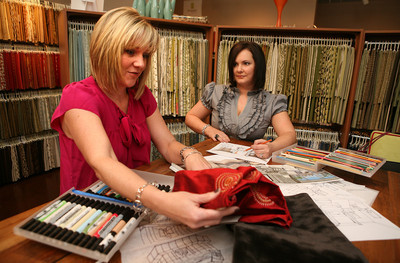A Head (Board) of the Times

Interior designers often talk about centering a room, even bringing a kind of narrative to the space, by finding and accentuating its focal point. In a living room it could be a fireplace, a window with a beautiful view, even a beloved piece of antique furniture that’s been in the family for years. But when it comes to the bedroom, it’s usually, well, the bed.
Simple, right? Just buy a great bedroom set with a headboard and move on. It’s not so simple.
Bedroom sets, or even just headboards, can reach into the thousands of dollars and they often fall flat by reflecting a mass-produced style. There are, however, other ways to accentuate the bed so that it brings the entire space together, punches up the drama or even tells a story — and it can be done with everything from a coat of paint to a piece of ironwork found at a local flea market.
When Michelle DiMauro and Heather Soto of Inhabit Design wanted to create some drama in a particular client’s bedroom, they went no farther than a local strip mall to scour the aisles of a Cost Plus World Market. They found curtains of hanging wooden rings and purchased four panels at a cost of less than $100. After painting the wall behind the bed a rich earth tone, they hung the panels of wood rings from the ceiling, which added dimension and a sense of height, then topped it off with a few colorful accent pillows on the bed.
“You can buy all kinds of alternatives,” DiMauro said. “I’ve seen panels of hanging shells. In my own house, I bought pieces of bamboo from Napa (Home and Garden) and cut them into thirds, laid down horizontal pieces and attached the others vertically, then hung them from the ceiling.”
It’s also easier than people think to create the look of a headboard. For a different client they created the illusion of a chocolate brown headboard trimmed in white by simply using paint and a roll of tape. In the center of this simple “headboard” they hung an ornately framed mirror they found at TJ Maxx. The cost for the entire project was about $75.
It’s also possible to use molding to create a headboard’s “trim” instead of paint stripes, DiMauro said. Molding also can be used to frame wallpaper panels that have been trimmed to fit the dimensions of a typical headboard. In fact, with so many choices in terms of design, texture and color pattern, you can really create a “wow factor” with wallpaper, particularly if the rest of the colors in the space are neutral, DiMauro said. It also can be used to pick up other colors in a decorating scheme.
“Say the room is in neutral browns and off-whites. You could use a bright pink or blue in the wallpaper, but with those browns and off-whites in it as well,” she said. “You can also pick up the tones in the wallpaper in accessories such as throw pillows.”
Other options include sayings or monograms that can be stenciled on the wall behind the bed and then painted, DiMauro adds. You can find stencils at craft stores and there’s even an online typography company called Wonderful Graffiti that not only sells transfers but allows customers to create their own designs, allowing them choice of color, words and embellishments.
Sometimes a bed can be turned into the center of attention with items normally found in other rooms of the house, or even outdoors. Quinn Larson, a color stylist with BEHR Paints, suggests hanging painted or crackled shelving units above the bed, mantel pieces, framed mirrors, wallpaper appliques, even picket fencing and old iron gates. Art canvases painted a solid color also can add a punch of color above the bed, she notes.
When it comes to choosing a paint color for the accent wall behind the bed, it’s important to keep a few things in mind, according to Larson. The larger the wall, the greater the color’s presence, so make sure the paint shade is something that won’t overwhelm the room. “Smaller areas sometimes support colors with a bit more vibrancy than large areas,” Larson noted.
Also, keep the furnishings in mind. Streamlined, modern furniture usually pairs well with a bolder, richer color, while country décor seems to go better with “softer, washed-out tones.”
The easiest way to choose an accent color is to look at what’s already in the room, such as the bedding or a favorite piece of artwork, adds Jackie Jordan, director of color marketing for Sherwin-Williams Paints. You can pull out a bold color from one of these items to create drama or, if the existing paint color on the walls is fairly neutral, play it safer by going just a few shades darker than the rest of the room.
And don’t be afraid of painters’ tape. One way to create an interesting graphic, Jordan added, is to tape off two squares or rectangles on either side of the bed, make X’s through the center and paint the alternating triangles in different shades of the same color. Another idea is to paint rectangles above the bed that serve as backdrops for artwork.
Overall, what’s unique about the bedroom is that it’s a very personal space so it gives do-it-yourselfers the chance to really have fun with decorating, she said, no matter what they do to bring the bed into focus.
“For the most part people experiment more with interior design in the bedroom because it’s a closed off space and people generally don’t see your bedroom,” Jordan said. “People are also getting more comfortable with color because they see it so much more in public places today.”